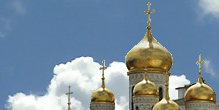 |
 |

|
 |
 |
QUESTION:
I am a teacher of Religion at a High School in England. At the moment I am teaching 10 pupils (they are 15 years old) about function in worship / symbolism / deeper meaning of the items that can be found in the church buildings of the mainstream Christian denominations.
I am from the Anglican church and therefore had to do some research on the Orthodox Church.
I would really value it if you could give me some ideas on the following: What, in your opinion, is the meaning/function/symbolism of the main items found in your church building?
I am thinking particularly about:
Ikonastasis
Ikons
Royal Doors
Incense
Sanctuary
Vestments of the priest
Altar
Why do these things look the way they do? How do they -- or how are they supposed to -- help in worship?
ANSWER:
Thank you for your enquiry. While I will have to be brief in my answers -- to cover each topic fully would fill a book -- I hope the following information will be of help to you.
What, in your opinion, is the meaning/function/symbolism of the main items found in your church building?
Ikonastasis and Ikons
Icons have been described as "windows to heaven." They are an aid in worship and prayer, focusing our attention on the Kingdom of God. The iconostasis, which in its present form developed around the 11th century, serves as an aid in our liturgical worship, rather than as an obstacle to "seeing what the priest is doing." On the iconostasis one finds numerous icons which recall for the faithful the story of our salvation in Jesus Christ and stand in testimony to the "wonderful things the Lord has done."
Royal Doors
These serve as the primary entrance into the altar. Only ordained clergy may walk through the Royal Doors, as only they have a reason to. On the Royal doors are icons of the four evangelists and the Annunciation, although there are variations on this.
Incense
Incense is not something found exclusively in the Orthodox Church, of course. As we read in the Psalms, incense signifies our prayers rising to God as a sweet fragrance: "Let my prayer arise in thy sight as incense, and let the lifting up of my hands be an evening sacrifice."
Sanctuary / Altar
In the Orthodox Church, the space in which the altar table occupies a central place is called the "Altar," and only occasionally referred to as the "sanctuary." This is the counterpart of the "Holy of Holies" in the Jerusalem Temple. It is in the Altar that the services are performed, and only those having a role in celebrating the services should enter it.
Vestments
While some people mistakenly believe that the vestments of the Orthodox Church are designed to "adorn" the clergy in a "special" way, this is not the case. Vestments serve to hide, in a sense, the individual characteristics of the priest, as these could indeed become a distraction in focusing on Christ. As St. John Chrysostom writes, "Christ does not appear until the priest disappears."
***
Why do these things look the way they do?
The cut of the vestments, style of the icons, shape of the altar, etc. look the way they do because that is how they evolved.
While the vestments of the Orthodox Church and the Western tradition have a common origin, their ultimate development varied from place to place. For example, the stole in the Orthodox Church is buttoned together -- in the West it is not. No particular reason -- that's just how it developed.
The "chasuble" of the west -- known in the Orthodox Church as the "phelonion" -- had the sides cut out in order to free the priests' hands and arms. In the Orthodox tradition the front was cut out in order to accomplish this. No theological or "symbolic" meaning here either -- just a practical problem solved.
In every instance, it is critical that meanings and "symbolisms" are not concocted to defend the development of things of a purely practical nature.
Published in January 2011.
Read more Christian articles
Recommend this page to your friend!
|
 |
 |

| Read also: |
|
|

|
|

